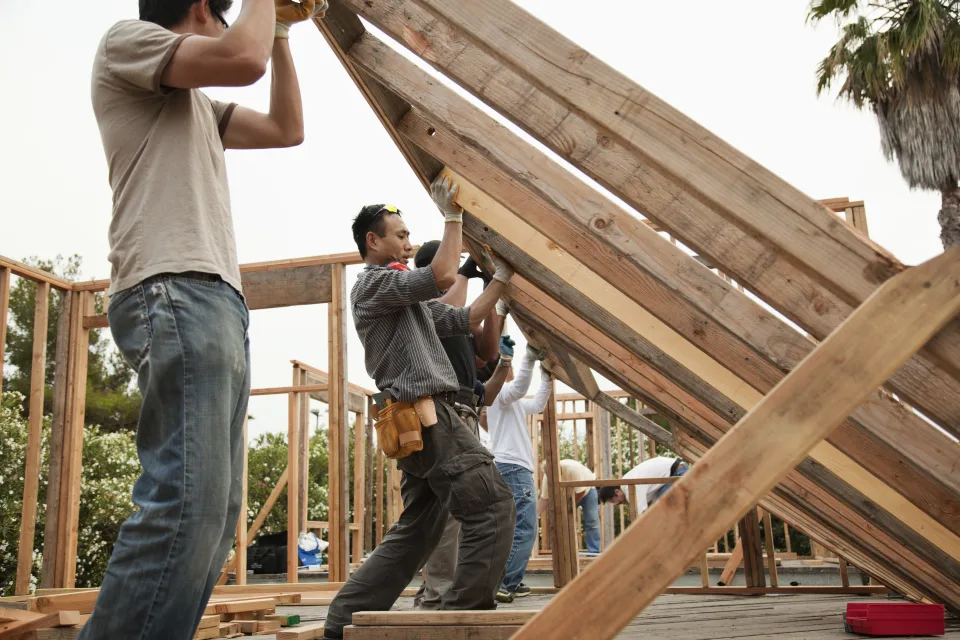Hiring in the construction industry isn’t slowing down.
Jobs in construction grew to 25,000, including 2,400 jobs added in residential construction in May, the Labor Department said on Friday. Over the past 12 months, construction has added an average of 17,000 jobs per month.
“While the housing industry, a very interest-rate sensitive sector, has been negatively impacted by the Federal Reserve’s monetary tightening, the construction labor market has not experienced a sharp decline,” Ksenia Potapov, economist at First American, wrote following the release.
“The continued strength is partially due to the years-long struggle that builders have had attracting and retaining skilled construction workers, making them less likely to part with skilled workers, even in a weaker housing market,” Potapov added.
The homebuilding rebound also reflects falling construction costs and increased demand from homebuyers who are contending with a major shortages in the resale market. That’s allowed developers to push ahead with previously approved projects — if they can find the talent.
“Residential contractors are benefitting from a severely undersupplied housing market and have seen growth in new home sales since September 2022,” Nick Grandy, construction senior analyst at RSM, wrote following Friday’s release.
For instance, new home sales jumped 4.1% to a seasonally adjusted rate of 683,000 units in April from the downwardly revised March rate of 656,000. That was 11.8% above the year-ago level and above economists’ expectations.
That’s led to a ramp-up in construction to meet this new demand.
A government report showed the pace of construction for single-family and multi-family units climbed 2.2% in April to a seasonally adjusted annualized of 1.401 million units. At the same time, building permits for single-home construction increased to a seasonally adjusted annual rate 855,000, up 3.1% from March’s revised rate of 829,000.
Still, the US is short of 1.7 million homes, according to data gathered by Chris Porter, chief demographer at John Burns Research and Consulting, while there’s a near-record number of homes under construction.
The need suggests that homebuilders will be keeping their attention on finishing off projects under construction rather than starting new ones, keeping single-family starts at bay and increasing demand for labor.
“There are still so many housing units under construction and we know you can’t automate away construction at this point so you will need more labor to complete those homes,” First American Deputy Chief Economist Odeta Kushi told Yahoo Finance in an interview.
Construction headwinds
While job openings for construction totaled 383,000 in April, or 35,000 fewer postings than a year ago, “it was still the second-highest total for April in the history of that series, which goes back to 2001,” Ken Simonson, Chief Economist, AGC of America, told Yahoo Finance.
But getting the talent needed is still a major headache.
“We are in high demand, the entire industry is,” Leslie Anderson, senior vice president of Training and Launch at Paul Davis Restoration, told Yahoo Finance. “Unfortunately, we don’t have a lot of candidates. The jobs outweigh the individuals we have applying right now.”
Monthly hires rose from 334,000 in April 2022 to 356,000 in April 2023. Layoffs in this sector also had an uptick from last year, drawing to 189,000, according to JOLTS. However, the ratio of construction hires per job openings — a measure of how easily employers can flip those openings to new employees — slipped, signaling the difficulty finding labor.
The lack of skilled labor has also prolonged the onboarding process from when the job is listed to when the candidate gets hired. Anderson said it depends on the role but it ranges between six weeks to three months.
“It’s become longer to find that person for us where it used to be we would find them quite easily — within a month. Now it’s extending,” Anderson said. The reasons vary for why candidates for construction are turning away.
“It’s hard work. You’re doing hard labor at times, you’re fighting the elements of Mother Nature — cold, heat, rain. And that is not for everyone,” she said. “It’s not an easy job as far as the labor component to it.”
The other headwind is the Federal Reserve.
The central bank’s chairman, Jerome Powell, remains firm on his message that the job situation remains very hot, a continued concern to squashing inflation, suggesting that the limited pool of available workers could drive wages higher and keep inflation above the Fed’s 2% inflation goal.
Average hourly earnings in construction rose 0.4% in May, and a 5.1% gain from last year, the Labor Department reported.
“Today’s report is a sticky wicket for the Federal Reserve. They have been hoping to see the labor market cool off so they pause on lifting rates further, but that is not happening, and the odds of another rate increase when they meet on June 15 has increased significantly,” Richard Branch, chief economist, Dodge Construction Network, told Yahoo Finance. “That will have a detrimental impact on construction starts – especially in the commercial sector.”

